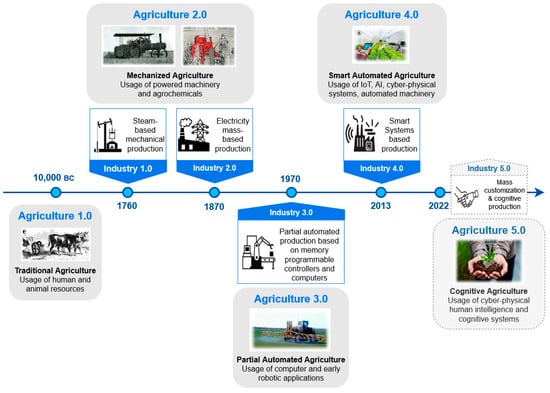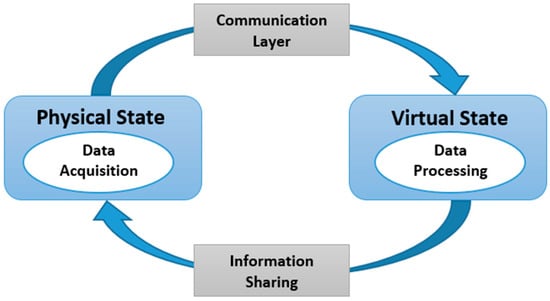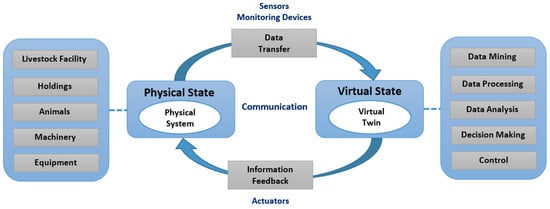You're using an outdated browser. Please upgrade to a modern browser for the best experience.
Please note this is a comparison between Version 1 by Eleni Symeonaki and Version 2 by Fanny Huang.
The potential application of the digital twins concept and its principles to all industries, including agriculture, has recently been the subject of considerable research interest. Since livestock farming is one of the mainstays of the agricultural industry, contributing to food security as well as employment and income generation, digital twins appear to be a promising technology to address issues related to the intensive nature of livestock production systems, which are typically characterized by high levels of input and output.
- digital twins
- livestock farming
1. Introduction
Food insecurity is a pervasive and pressing global issue that has far-reaching consequences for individuals, communities, and nations. Given that the world population in 2022 reached almost 8 billion and is expected to exceed 10 billion by the later part of the 21st century [1], the Food and Agriculture Organization (FAO) of the United Nations predicts that the production of food commodities needs to increase by at least 50% compared to 2012 [2]. On top of that, food insecurity is exacerbated by the intensification of occurrences of unusually severe weather events due to climate change and the economic crises, as well as ongoing armed conflicts like the Russo–Ukrainian war or other contingent circumstances, for instance, the COVID-19 pandemic [3]. Therefore, it seems imperative to ensure food security through higher agricultural productivity without compromising the long-term sustainability and resilience of agro-ecosystems [4]. In this sense, agricultural production systems face the challenge of meeting a rising food demand along with climate change-related conditions, the deterioration of natural resources due to their uncontrolled exploitation, the loss of biodiversity, and the increased food waste caused by the deficiencies in the agri-food supply chain while remaining profitable [5].
Considering the importance of the agricultural production system as a main pillar of the primary sector of industry, various scientific and technological approaches have been devised and implemented over time to increase the efficiency of their outputs [6]. Indeed, the agricultural sector has evolved throughout history, alongside the technological developments of all industrial revolutions, as illustrated in Figure 1, from the first agricultural revolution under the term “Agriculture 1.0” to the current agricultural revolution, attributed as “Agriculture 5.0” [5][7][5,7], which represents the emerging trend that the agricultural sector is going to adopt in the upcoming years. In particular, the concept of Agriculture 5.0 focuses on transforming agricultural production systems through the integration of the recent advancements in smart technologies [8] so as to enhance their efficiency while making them environmentally sustainable [9].

Figure 1.
Timeline of industrial and agricultural revolutions.
Rapid progress in the application of leading-edge technologies, such as wireless sensor networks (WSNs) and real-time sensing [10], artificial intelligence (AI) [11] and machine learning (ML) [12], edge computing [13], big data analytics and the Internet of Things (IoT) [14] as part of Agriculture 4.0 [15], are enabling agricultural production systems to be fully data-driven in the context of Agriculture 5.0 [16] and, therefore, raise attention in the digital twins (DTs) concept and their feasible applications in the agricultural sector to achieve the objectives of sustainable development [17]. Actually, based on the integrated farm management (IFM) approach [18], an agricultural production system is potent at adapting to dynamic changes [19] as it is updated on a continuous basis and in real time based on data feedback from sensors and devices that collect the parameters related to the properties of its physical entities and environment, as well as the system itself [8][20][8,20]. In this respect, the DTs concept enables the virtual replication of physical entities with corresponding digital ones that are accurate and “live” [21], bridging them according to a cyber-physical architecture under which any change that occurs in the physical entities simultaneously and continuously modifies their virtual twins [22].
The potential of applying the DTs concept and the principles it represents to all industrial sectors, including the agricultural one, has lately gained great research interest, as reported in the recent literature [22][23][24][25][26][27][22,23,24,25,26,27], concerning the case of arable agriculture in particular. In this area, DTs represent virtual representations of extensive fields. These digital replicas enable farmers to accurately understand critical factors, such as soil health, moisture levels, and crop growth [28]. This approach goes beyond conventional practices, offering targeted interventions and resource optimization through the ability to rapidly adapt to evolving conditions and ensure resilience against uncertainties [29].
Likewise, considering that livestock farming is one of the leading sectors of the agricultural industry, adding to food safety [30], as well as creating work opportunities and income, DTs may emerge as a promising technology for addressing issues related to the intense nature of livestock production systems [30], which are typically characterized by high levels of input and output per farming unit [31]. To this end, by creating virtual counterparts of livestock and the environment, DTs can facilitate the real-time monitoring of individual animals, providing farmers with insights into feeding patterns, stress factors, and optimal breeding strategies, allowing for a proactive approach to health management as well as disease prevention, thereby ensuring not only productivity but also the welfare of the livestock [32].
Despite the prominent benefits that derive from the integration of the DTs technology into livestock production systems, the number of works in the literature that review recent advances in DTs technology (with a focus on their applications in livestock production systems) has been, to the best of ouresearchers' knowledge, rather limited to date.
2. Digital Twins Concept Integration in Livestock Farming
2.1. The Digital Twins Concept
The digital twins (DTs) concept was initially conceptualized by Michael Grieves, referring to the management of the product life cycle in 2003 [33]—a virtual version of a physical product comprising information about the product in question [34]. In a more specific definition, a DT can be attributed as a virtual copy of a product, process, or service that incorporates all of the above features [35]. Miller et al. [36] further extended the definition of the DTs concept as the integration of multiple models within a model-based enterprise. According to this definition, a digital twin can be formed by establishing associations between different models as well as relationships between the data stored in various domains. Stark and Damerau [37] provided a more comprehensive definition of the DTs concept by describing it as “a digital representation of an active unique product (real device, object, machine, service, or intangible asset) or unique product-service system (a system consisting of a product and a related service) that comprises its selected characteristics, properties, conditions, and behaviours by means of models, information, and data within a single or even across multiple life cycle phases”. While the meaning of the DTs concept may seem straightforward, its definition is debated and constantly evolving, as is reported in the literature [38][39][40][41][38,39,40,41]. The various existing definitions are characterized by specific features deriving from multiple use cases employing the DTs concept. What may be expressed in the simplest terms, is that a DT consists a digital duplicate of an existing physical entity [23].
The lack of consistency in the definition of the DTs concept makes the identification of its main components rather challenging. As DTs was first introduced by Grieves [33], it applies to a system constituted of three principal subsystems: (a) the real space with the physical products, (b) the cyberspace with the virtual products, and (c) the interconnection of the virtual and real products via data and information. Based on this structure, the DTs flow is represented as a loop, called twinning, where data are directed from the physical to the virtual state, while information and processes are directed in reverse, as depicted in Figure 2 [26]. This concept has been recently extended by Tao et al. [42] to five components, involving data and services as a part of a DT system, while in [43], verification, validation, and accreditation were also identified as components of a DT system, stating that cyber and physical space are seamlessly integrated.

Figure 2.
The basis of the digital twins concept.
Establishing a commonly accepted definition of the DTs concept constitutes a step forward in the advancement of this technology. By contextualizing future use cases of DTs in a unified notion and terminology, a broad set of the diverse DTs physical entities may be implemented in a way that remains consistent with the DTs paradigm so that its intended benefits can be fully achieved and shared across all sectors.
2.2. The Digital Twins Concept in Livestock Farming
Τhe livestock sector is undergoing rapid development on a worldwide level as a result of the growing demand for animal products, driven by the need for food safety [44] due to population increase and rapid urbanization, as well as stimulating prosperity in the industrialized world and most developing countries [45]. In addition to the potential benefits associated with the growing development of the livestock sector, a number of challenges seem to arise from operational, socio-economic, environmental, and sanitary issues [30].
That which is characteristic of livestock production systems (at present) is their intensive nature, which is associated with both greater volumes of inputs (i.e., farm size, manpower, financial resources, etc.) and outputs per production holding. In this perspective, the number of holdings is declining, while the number of animals reared in closed, environmentally controlled, automated facilities is rising [46]. Moreover, vertical integration is often embedded in the view that a single company can be in charge of the overall production system (e.g., from the feed mill to the processing plant), which is configured to achieve maximum output with all of its components running consistently at full load [47]. Therefore, whatever disorder may occur at any stage of the production chain will lead to a direct impact on both the upstream and downstream levels, with direct implications not just for animal welfare but for humans and the wider environment as well. This fact is aligned with the emergent notion of “One Welfare”, an approach which, as reported in [48], gives recognition to the immediate and implicit associations between animal welfare and the well-being of people and the broader environment.
In response, the entire digitization of livestock production systems is often suggested [17] in the context of Agriculture 4.0 and, consequently, Agriculture 5.0 [5][7][5,7]. According to this approach, computationally enabled technologies [8], incorporating smart sensors, WSNs, AI and ML, Edge computing, big data analytics, the IoT, and other cutting-edge technologies, with DTs among them, are considered to be of great importance.
To this end, when integrating the DTs concept in livestock farming, the physical state accounts for a physical system that embodies the composite and dynamic environment of livestock facilities, with the boundaries of the DTs specified [49]. Herein, it has to be noted that the physical system is a fundamental component of a DT since the lack of it implies that the physical state merely represents a model [50]. To this end, the physical system involves the fundamental features of the incorporated physical objects and devices [51]; it can be comprised of an entire object with individual components found in a physical environment, a single component of the object [50], or an individual property of the object that is linked to other objects. In the case of livestock production systems, the physical system may indicatively consist of an entire facility, including animals, holdings, machinery, equipment, and feeding strategies, as well as a number of animals or just an animal body [52]. Finally, monitoring and sensing devices [53] are incorporated into the physical system so as to collect the data required. Accordingly, the virtual state accounts as a representation of the physical state model and data. By involving data mining, processing, and analytics by means of AI and ML techniques, the virtual state provides feedback for supporting decision-making and controlling the physical system so as to foresee any obscure matters and optimize its operation [54]. Finally, the twinning, which enables the interconnection between the physical and virtual state, accounts for the transmission of data from the physical system to its virtual twin, as well as for the reverse information feedback [55] to the livestock production system. The type of techniques incorporated for establishing such interconnection depends on the data volume, type, and source as well as the speed and rate that is required for achieving the minimum accepted delay both of the data transmission and information feedback [52][56][52,56]. Based on the aforementioned, Figure 2 has been elaborated upon, resulting in Figure 3, which depicts a schematic of the DTs concept in livestock farming.

Figure 3.
The digital twins concept for livestock farming.
